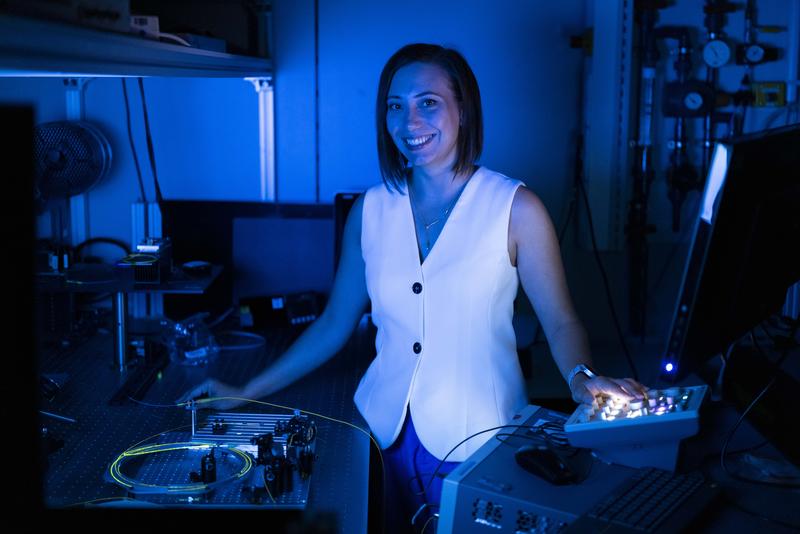Laser flashes at quadrillionth-of-a-second pace: Maria Chernysheva receives funding from the DFG Heisenberg Program
A laser pulse in Dr. Maria Chernysheva’s research lasts only about 100 femtoseconds, or in numbers: one millionth of a billionth of a second. To put this into perspective, it is as short as four hours in the entire 4.54-billion-year history of the Earth. With these ultrafast lasers, she aims to open up new possibilities for medical diagnostics, laser surgery and monitoring greenhouse gases. Maria Chernysheva, a researcher at the Leibniz Institute of Photonic Technology (Leibniz IPHT) in Jena, has now been accepted into the Heisenberg Program of the German Research Foundation (DFG).
Chernysheva’s research focuses on lasers that operate from 2.5 to 5 micrometers. In this mid-infrared range, water, many biomolecules, and greenhouse gases absorb light strongly that is crucial for noninvasive tissue analysis and precise environmental measurements. “Efficient, high-brightness light sources in this range are still missing,” says Dr. Maria Chernysheva. “That makes the research especially exciting. Since standard fiber technology cannot be used, we test new materials and designs, look closely at the underlying physics, and solve challenges step by step. Each stage brings us closer to applications like high-precision diagnostics or gentle, high-precision surgical procedures.”
Research with freedom
At Leibniz IPHT, Maria Chernysheva and her junior research group investigate novel ultrashort-pulse fiber lasers. The Heisenberg funding gives her the independence to set her own priorities, including projects that involve risks but hold strong application potential. “The program allows us to grow the team with a long term perspective, strengthen international collaborations, and pursue ideas that don’t fit into shorter funding schemes,” she says.
“Maria Chernysheva combines custom specialty glass fibers from our fiber drawing tower with innovative laser architectures in the mid-infrared,” says Prof. Jürgen Popp, PhD, Scientific Director of Leibniz-IPHT. “This leads to systems that we can tailor with partners for medical diagnostics and environmental analysis — a clear example of how materials development, laser physics, and application-oriented research come together at Leibniz IPHT.”
From Moscow via Birmingham to Jena
Maria Chernysheva earned her PhD in laser physics in Moscow, conducted research at Aston University (UK), and first came to Leibniz-IPHT in 2018 through the international Women in Photonics workshop. Since 2019 she has led her junior research group in Jena, working closely with the institute’s fiber team. The in-house fiber drawing tower produces tailor-made specialty fibers that her team integrates into new laser architectures for the mid-infrared. “One of the great strengths of Leibniz IPHT is that we can cover the full chain — from fiber fabrication and laser design to applications in medicine, environmental analytics, and sensing,” she says.
With the new funding, Chernysheva’s team aims to develop more efficient, high-brightness light sources in the mid-infrared, make them robust, and test prototypes with clinical and industrial partners in real-world environments — turning new knowledge into concrete diagnostic and measurement solutions.
Die semantisch ähnlichsten Pressemitteilungen im idw


